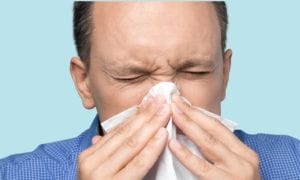Written by Taylor Woosley, Staff Writer. 12 weeks of oral administration of Lactobacillus paracasei IJH-SONE68 significantly reduced symptoms, such as nasal congestion and watery eyes, related to chronic allergies.
 Allergic rhinitis (AR), a chronic inflammatory condition of the nasal mucosa, is one of the most common chronic diseases of the upper airways 1. This disorder affects 20% to 30% of adults in the United States and Europe, with a possibly higher percentage of diagnoses occurring in children 2. Allergic rhinitis, which often co-occurs with asthma, is caused by immunoglobulin E (IgE) mediated reactions to the inhalation of seasonal or perennial allergies 3. Common symptoms include sneezing, nasal itching, congestion, and sleep deprivation, with many sufferers reporting a negative impact on their quality of life 4. Allergic rhinitis is often treated with conventional medication or allergen immunotherapy, but many patients fail to respond to these therapeutic efforts.
Allergic rhinitis (AR), a chronic inflammatory condition of the nasal mucosa, is one of the most common chronic diseases of the upper airways 1. This disorder affects 20% to 30% of adults in the United States and Europe, with a possibly higher percentage of diagnoses occurring in children 2. Allergic rhinitis, which often co-occurs with asthma, is caused by immunoglobulin E (IgE) mediated reactions to the inhalation of seasonal or perennial allergies 3. Common symptoms include sneezing, nasal itching, congestion, and sleep deprivation, with many sufferers reporting a negative impact on their quality of life 4. Allergic rhinitis is often treated with conventional medication or allergen immunotherapy, but many patients fail to respond to these therapeutic efforts.
In recent years, researchers have observed the potential positive effects Lactobacillus paracasei IJH-SONE68 may have on allergic rhinitis. Lactobacillus paracasei IJH-SONE68, a bacterium isolated from a fig leaf, has been shown to be effective for the immune modulation of allergic symptoms 5. Additionally, this bacterium provides anti-inflammatory and antimicrobial properties, along with enhancing immune system stimulation 6. In particular, a novel exopolysaccharide (EPS) produced by the strain may prevent and improve allergic symptoms in patients with allergic rhinitis 7.
In this double-blind, placebo-controlled, randomized comparative clinical trial, researchers explored the potential role supplementation with Lactobacillus paracasei IJH-SONE68 may have for participants suffering from chronic allergies. Sixty subjects (males and females between the ages of 21 and 70) were instructed to either take the IJH-SONE68 powder capsule or placebo every day for 12 weeks. Inclusion criteria were that healthy subjects must have a slightly elevated score on a self-assessment questionnaire for allergic symptoms and a high score for the visual analogue scale (VAS), indicating that their allergic symptoms provide difficulty in daily life activities. Furthermore, subjects were assigned to have a physical examination, answer the self-assessment questionnaire, and provide their VAS value score every four weeks. Blood measurements were taken to obtain serum specific IgE levels and biochemical measurements.
After 12 weeks of daily supplementation, the results were as follows:
- When comparing the self-assessment questionnaire answers before and after 12 weeks of supplementation, the average scores for head dullness, watery eyes, and frequency of nose-blowing significantly decreased in the IJH-SONE68 group compared to placebo (p <0.05).
- There was no significant difference between the two groups for changes in the total IgE levels, although there was a slight decrease in the IJH-SONE68 group.
- In the IJH-SONE68 group, blood analysis showed significant improvement in serum levels of AST, ALT, ALP, and ChE, indicating that IJH-SONE68 may improve lipid metabolism and liver health, while also reducing markers for inflammation.
- A trend difference between the change in body fat percentage was observed in the two groups (p=0.058), suggesting that IJH-SONE68 may also provide an anti-obesity effect.
In conclusion, results of the study indicate the potential use of Lactobacillus paracasei IJH-SONE68 to prevent or decrease the severity of symptoms related to allergic rhinitis. The robust anti-inflammatory and immune-modulating potential of this bacterium should be further explored to better understand its therapeutic properties. Study limitations include the small sample size of the study, which affected the observation of potential changes in IgE levels due to lack of participants with specific IgE-positive results. Noda et al suggest future studies should observe the anti-obesity effects of IJH-SONE68 and its role in lipid metabolism.
Source: Noda, Masafumi, Keishi Kanno, Narandalai Danshiitsoodol, Fumiko Higashikawa, and Masanori Sugiyama. “Plant-Derived Lactobacillus paracasei IJH-SONE68 Improves Chronic Allergy Status: A Randomized, Double-Blind, Placebo-Controlled Clinical Trial.” Nutrients 13, no. 11 (2021): 4022.
© 2021 by the authors. Licensee MDPI, Basel, Switzerland. This article is an open access article distributed under the terms and conditions of the Creative Commons Attribution (CC BY) license (https:// creativecommons.org/licenses/by/ 4.0/).
Click here to read the full text study.
Posted January 28, 2022.
Taylor Woosley studied biology at Purdue University before becoming a 2016 graduate of Columbia College Chicago with a major in Writing. She currently resides in Glen Ellyn, IL.
References:
- Licari A, Castagnoli R, De Filippo M, et al. Current and emerging biologic therapies for allergic rhinitis and chronic rhinosinusitis. Expert Opin Biol Ther. Jun 2020;20(6):609-619. doi:10.1080/14712598.2020.1729350
- Hoyte FCL, Nelson HS. Recent advances in allergic rhinitis. F1000Res. 2018;7doi:10.12688/f1000research.15367.1
- Bousquet J, Anto JM, Bachert C, et al. Allergic rhinitis. Nature reviews Disease primers. Dec 3 2020;6(1):95. doi:10.1038/s41572-020-00227-0
- Drazdauskaitė G, Layhadi JA, Shamji MH. Mechanisms of Allergen Immunotherapy in Allergic Rhinitis. Curr Allergy Asthma Rep. Dec 12 2020;21(1):2. doi:10.1007/s11882-020-00977-7
- Noda M, Sultana N, Hayashi I, Fukamachi M, Sugiyama M. Exopolysaccharide Produced by Lactobacillus paracasei IJH-SONE68 Prevents and Improves the Picryl Chloride-Induced Contact Dermatitis. Molecules. Aug 16 2019;24(16)doi:10.3390/molecules24162970
- Bengoa AA, Dardis C, Garrote GL, Abraham AG. Health-Promoting Properties of Lacticaseibacillus paracasei: A Focus on Kefir Isolates and Exopolysaccharide-Producing Strains. Foods. Sep 22 2021;10(10)doi:10.3390/foods10102239
- Cho DY, Hunter RC, Ramakrishnan VR. The Microbiome and Chronic Rhinosinusitis. Immunol Allergy Clin North Am. May 2020;40(2):251-263. doi:10.1016/j.iac.2019.12.009
